This article may contain affiliate/compensated links. For full information, please see our disclaimer here.
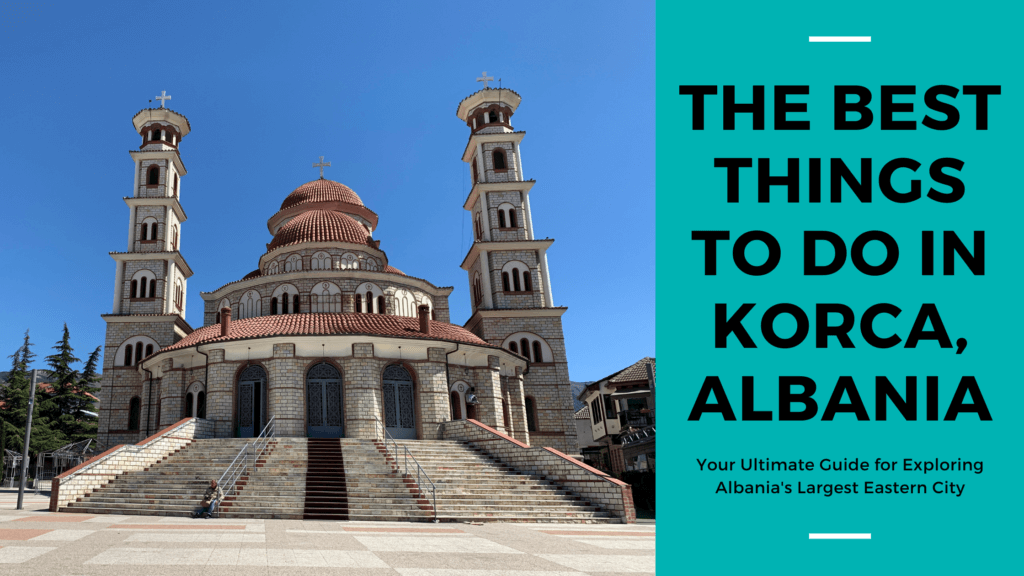
WATCH: First Days in Korca, Albania and Breaking into the Korça Brewery (Accidentally!) on YouTube
Korca (also spelled Korça or Korçë) is a beautiful city in southeastern Albania. It is located at the foot of Morava Mountain and extends to the edge of the Morava Valley.
Korca is mentioned in historical reports as far back as the 13th century during the Byzantine empire, though it is thought to have existed as far back as the 11th century.
Today, Korca is Albania’s 8th largest city and the most populated city in eastern Albania. It is well known due to its strategic location, culture, history, and of course as the producer of Albania’s first beer, Birra Korca!
Why Visit Korca?
There is plenty to do in Korca! In this article, we’ll share some of the best places you can visit in Korca, where to eat and drink, plus day trips you can make outside the city.
We’ve also created this Google MyMap of Korca so you can see all of the locations listed below.
Getting to Korca
Korca can easily be reached by bus from surrounding cities.
We took a bus from Tirana, Albania’s capital city, to Korca, which is about a 165 KM journey and takes around four hours. The bus from Tirana to Korca cost 700 Lek per person.
The bus journey takes you through Elbasan, Podgradec, and many other smaller towns along the way. The views are spectacular, especially when you drive by Lake Ohrid, Europe’s oldest and deepest lake.
As you can see in this video, figuring out the bus from Tirana to Korca didn’t go very smoothly for us because we went to the wrong bus station in Tirana.
This is the Google map location for the correct bus station in Tirana where you can catch the bus to Korca. The bus arrives at the main bus station in Korca.
Korca is about 260 Km from Thessaloniki, Greece, and about 250 Km from Skopje, North Macedonia and can be reached by bus from either city. Times and prices may vary depending on the time of year.
Where to Stay in Korca, Albania
Korca is a very walkable city and it is easy to get around on foot. A majority of the sidewalks are well paved unless you venture off onto the side roads where there are still many winding cobblestone lanes.
Depending on your mobility, we recommend choosing accommodation that is within 2 Km of The Resurrection of Christ Cathedral (Search: Katedralja Ortodokse “Ringjallja e Krishtit” on Google Maps) which is in the center of town.
These are some hotels that are near the center of town:
Korca Boutique Hotel
Life Gallery Hotel
Vila Eden Boutique Hotel
Korca Backpackers Hostel
Things to do in Korca, Albania

1. Go to the Korca Brewery (Birra Korça)
We love a good beer and, in our opinion, Korça beer is the best in Albania! You can find it in restaurants and bars all across the country, but it will never be fresher than when you drink it straight from the Korça brewery or at the beer garden next door.
Korça Beer is the first Albanian beer. The Birra Korça factory was founded in 1928 and was designed by an Italian architect.
The factory and beer garden next door are located at the base of Morava mountain and are easy to reach by foot from Korca’s city center.
The beer garden is big and open, and we can imagine that it is a fantastic place to spend some time in the summer. There is also indoor seating for the cooler months.
Prices at the beer garden are very affordable. Beers were 100 Lek for a 500ml bottle and 70 Lek for a 400ml draft at the time of our visit. There are food and snacks available such as sausages, veggies, cheese, and french fries which pair great with the beer.
At the time of our visit, we were able to get an unofficial tour of the brewery due to Jen accidentally breaking in. However, from what we have heard, official tours are only offered at certain times of the year.
Be sure to check the Birra Korça website ahead of time or send them a message to inquire about brewery tours and tastings.
The Korça Beer Festival takes place every year in August and is one of the biggest events in Albania! The next Korça Beer Festival is from August 14-18, 2022.
Opening Hours: The beer garden and restaurant are open from 8am-midnight, according to Google.
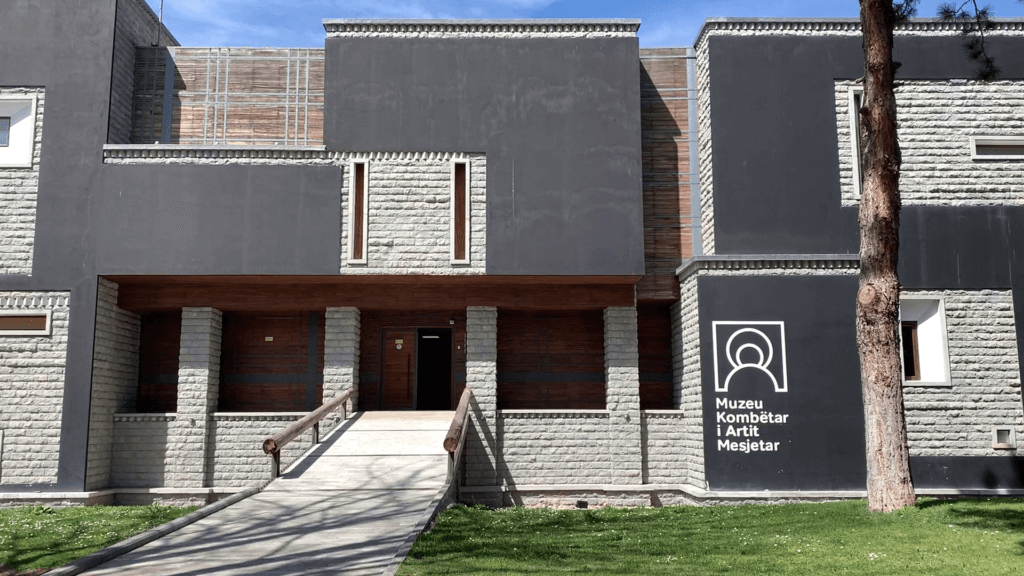
2. The National Museum of Medieval Art
Stevo and I have been to a lot of museums all around the world, but this museum was one of the most impressive and interesting we’ve ever been to! If you’re a history and art lover, we think you’ll love it too.
The museum is dedicated to medieval art and history in Albania. It is filled with over 7,000 art and cultural items including stone, metal, wood, and fabric pieces dating all the way back to the 13th century and earlier!
The works of anonymous and more well-known artists are on display including Onufri, Onufër Qiprioti, David Selenica, Teacher Kostandini, and the Zografi Brothers.
The museum is well laid out and there is an audio guide to take you through the galleries to explain many of the more important works to make the experience more meaningful. The audio guide is included in the price of your ticket.
We thought it was incredible to be able to could get so close to such ancient and well-preserved pieces to really see the details and textures. In that sense, this museum feels very special.
We’re so happy we visited the Museum of Medieval Art early on in our trip because we began to recognize different works of art and artists when visiting historic churches and other sites around Albania based on what we learned in the museum.
The Museum of Medieval Art is nearby Birra Korça, so you can plan to visit there after!
Opening Hours: April- September, Every Day 9:00am – 7:00pm, October – March, Tuesday- Sunday 9am – 2pm, 5pm – 7pm
Ticket Price: 700 Lek Standard, 200 Lek Students
Website: Korca National Museum of Medieval Art
Do you need Travel Insurance for your trip to Albania? Get quotes from World Nomads and SafetyWing.

3. The National Museum of Education & The First Albanian School (Mësonjëtorja)
The Albanian School in Korca was the first secular school in the Albanian language and was an important center of cultural and patriotic education for the country.
The school was opened as part of the Albanian National Movement with the goal to create an independent Albania because the rights of the Albanian people were denied within the Ottoman Empire.
Prior to the school’s opening, giving lessons in the Albanian language had to be done in secret due to Ottoman rule.
The Albanian school was opened during the late Ottoman period on March 7, 1887. This day is still recognized in Albania as Teacher’s Day.
Today, the school building serves as a museum and preserves the history of this important site of education and history in Albania.
The museum is located on St. George pedestrian boulevard.
Opening hours: Monday – Saturday 9am – 4pm, Sunday 10am – 3pm, Closed on Monday
Ticket price: 300 Lek for Adults, 90 Lek for Students (age 12-18 with ID), Free for Children under 12
Website: Read more about the school here.
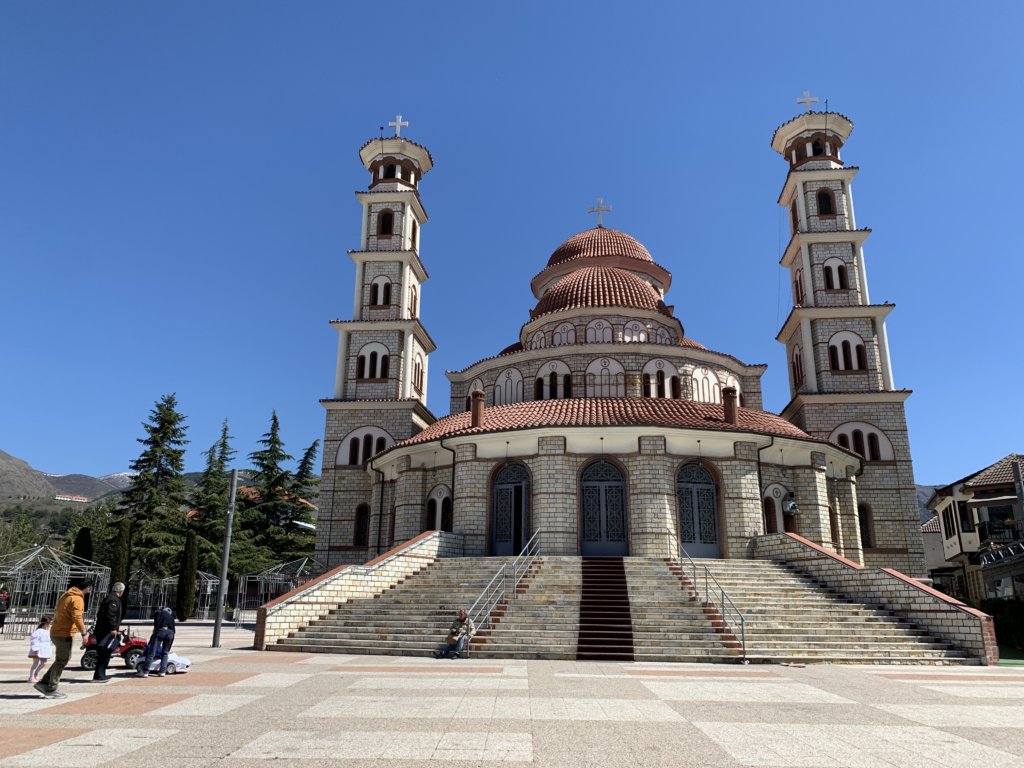
4. The Resurrection of Christ Cathedral (Katedralja Ortodokse “Ringjallja e Krishtit”)
The Resurrection of Christ Cathedral is the most famous landmark in Korca and is the main site of worship for Korca’s Orthodox community.
It is located at the crossroads of Boulevardi Republika and St. George’s pedestrian boulevard in the city center.
The Resurrection of Christ Cathedral was the first Orthodox cathedral to be built in Albania after the fall of the communist regime. Construction began in 1994 and was completed in 2004 thanks to the financial support of the Greek Orthodox Church and the Albanian diaspora. It is among the largest Orthodox churches in the Balkans.
The Resurrection of Christ Cathedral was built in a neo-Byzantine style. Inside it is beautifully decorated with colorful frescos, icons, chandeliers, and wooden iconostasis.
You can visit inside The Resurrection of Christ Cathedral and candles are available to purchase.
Opening Hours: According to Google, The Resurrection of Christ Cathedral is open 24 hours 7 days per week.
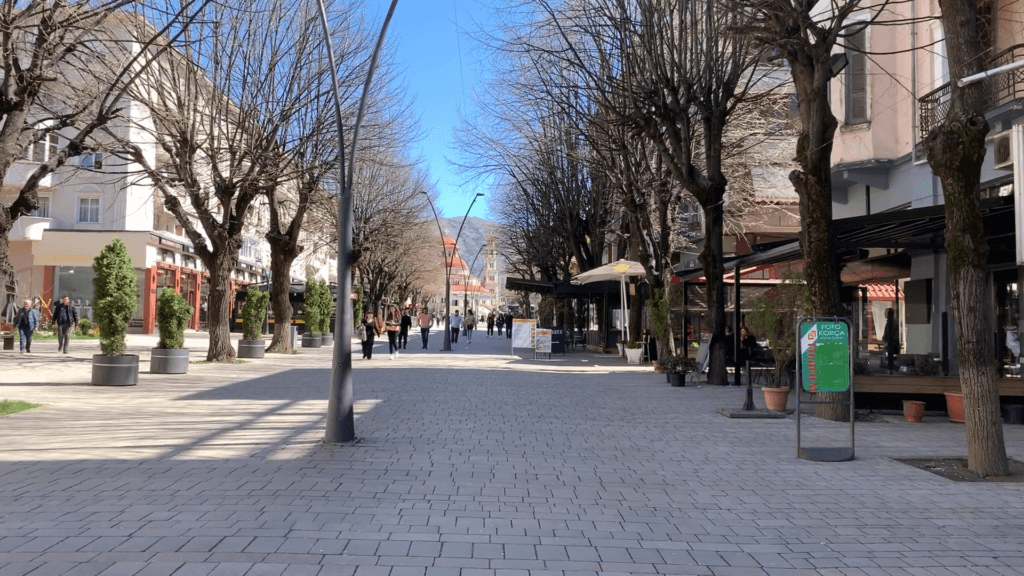
5. St. George Pedestrian Boulevard (Shën Gjergji)
When you step out the doors of The Resurrection of Christ Cathedral, you’ll be facing St. George pedestrian boulevard, Korca’s main walking street.
The street is lined with trees and is a pleasant place to take a stroll at any time of day. Albanians love to take walks in the early evenings, and you’ll notice that St. George’s pedestrian boulevard is bustling with people at this time of day.
Along the walking street, there are restaurants, cafes, bars, and shops where you’ll find people shopping or enjoying a meal or a coffee at any time of day.
You’ll also find The National Museum of Education, the back entrance to the Gjon Mili Photography Museum (inside the bright yellow building), and the former site of St. George Cathedral, which was destroyed during communism in 1971, and is outlined in white stone along the boulevard.
At the end of the walking street, there is a panoramic tower that looks out over Korca. Unfortunately, it was closed at the time of our visit.
6. Gjon Mili Photography Museum (inside the former Romanian House)
Inside the former Romanian House located on St. George’s pedestrian boulevard (it’s a bright yellow building, you can’t miss it!) is the Gjon Mili Photography Museum dedicated to the famous Albanian-American photographer who was born in Korca.
Mili was one of the greatest photographers of the 20th century.
The museum houses a large collection of his photographs which are truly a sight to behold. He was one of the first photographers of his time to play with light in the ways that he did, propelling him to fame in the US where he worked with and befriended some of the most famous celebrities and artists of his time.
We didn’t realize that the front entrance to the museum is around the corner of the building, just off the walking street, where you can purchase your ticket and a guide will bring you through the museum. Because we went in without a guide we weren’t able to do the interactive part of the museum, which looked very interesting! Don’t make the mistake we did and go around to the front entrance.
We recommend you request to start the tour on the top floor where you can learn more about Gjon Mili’s life, his family, and the celebrities and artists he worked with before viewing his collections.
The museum takes about 45 minutes to go through and is well worth a spot on your Korca itinerary!
Opening Hours: Tuesday-Sunday from 9am–2pm, 5pm–7pm. Closed on Mondays.
Ticket Price: 200 Lek

7. Korca Bazaar (Pazari i Vjetër)
Soak in the atmosphere of the Korca Bazaar, one of the ancient, central parts of the city that has been renovated into a modern-day plaza for people to congregate, shop, eat, drink, and sometimes enjoy music and performances as well.
Inside the bazaar, you can admire the old city architecture that has been renovated to its former glory. Wander through the winding cobblestone streets and check out the variety of shops, cafes, and restaurants.
Although it may appear touristy, you’ll find that the vast majority of people spending time there are locals. Cafe culture is big in Albania and there are plenty of cafes and bars inside to choose from.
We visited the Korca Bazaar once in the morning and once in the late afternoon.
In the morning, we found a nice table in the center of the bazaar on the cobblestones to sit in the sun and enjoy a coffee. You really can’t go wrong with any of the cafes inside the bazaar!
In the late afternoon, we found a table on the opposite side of the bazaar where the setting sun could reach us and enjoyed some Korca beers and bar snacks.
We were there on a weekday, and at both times of day the bazaar was filled with people relaxing and chatting. It was a lovely atmosphere.
There are also many restaurants inside the bazaar where you can enjoy a full meal and shops selling traditional goods, second-hand items, souvenirs, and we even saw a tattoo parlor!
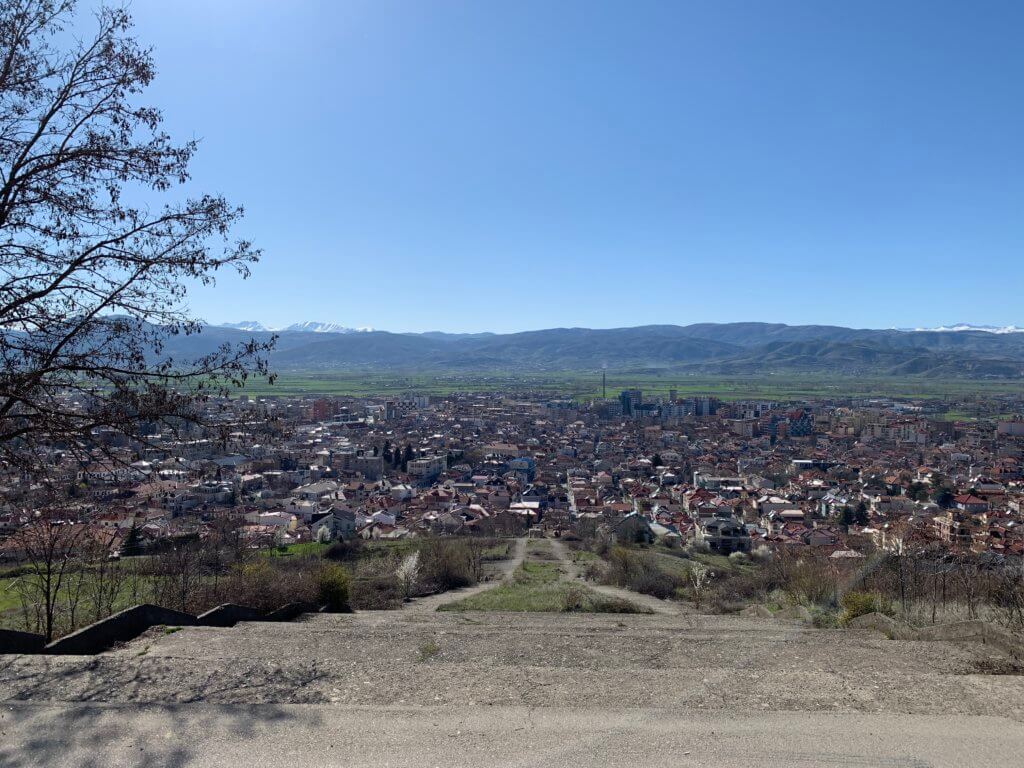
8. Martyrs’ Cemetery in Korca
Also known as the Heroes’ Cemetery, the Martyrs’ Cemetary features a large statue of a soldier with a raised fist located on a hill in Korca. The statue is in memory of fallen soldiers who died during World War II in Albania.
To be honest, the Martyrs’ Cemetery was not our intended destination when we went there. I just wanted to see where a cute cobblestone street next to where we’d just had lunch led to. It turned out it led up to the cemetery!
The views from up on the hill just below the cemetery are the reason to make the climb. You can look out over Korca and the surrounding fields, villages, and mountains in the distance.
How to Get There
Just to the right of FindFour restaurant is a cobblestone street leading up towards the Martyrs’ Cemetery. It’s about a 20-30 minute walk to reach the cemetery from Find Four.
First, you walk up the cobblestone street and then up some very old, not well-maintained stairs. But the views are worth the climb!
Once you reach the cemetery, there is a road and walking paths in either direction that you can take to explore further as you take in the views.
9. Morova Mountain Hike to the Old Church
When you look up at Morova mountain, you’ll see a church and a huge cross perched at the top. It is possible to hike up to the top of the mountain and you can go into the church as well. You can also take a taxi up the mountain to the church.
We didn’t do this hike during our time in Korca, but it’s on the list for our next visit!
Where to Eat in Korca: The Best Korca Restaurants
We need to shout out to our Airbnb host in Korca and our Instagram followers Krissy and her husband, who is originally from Korca, for their excellent restaurant recommendations. There is nothing better than recommendations from locals, and we really appreciate it when people reach out to give us suggestions!
Breakfast
Pie’s House is a traditional burek stall at the Korca Bazaar where they also sell a Korca specialty called Lakror. Lakror is a flaky, filled pastry that is a must-try when you are in town. We tried two kinds, the white bean, and spinach with cheese. Both were delicious!
Another bakery recommendation is Bugaca Greke.
There are many bakeries around Korca where you can find burek, lakror, and other tasty pastries. Why not try a different bakery every day?
There is an annual Lakror Festival (Festa e Lakrorit) held in Korca as a celebration of summer and Albanian cuisine. It is a one-day festival usually held in late July or early August.
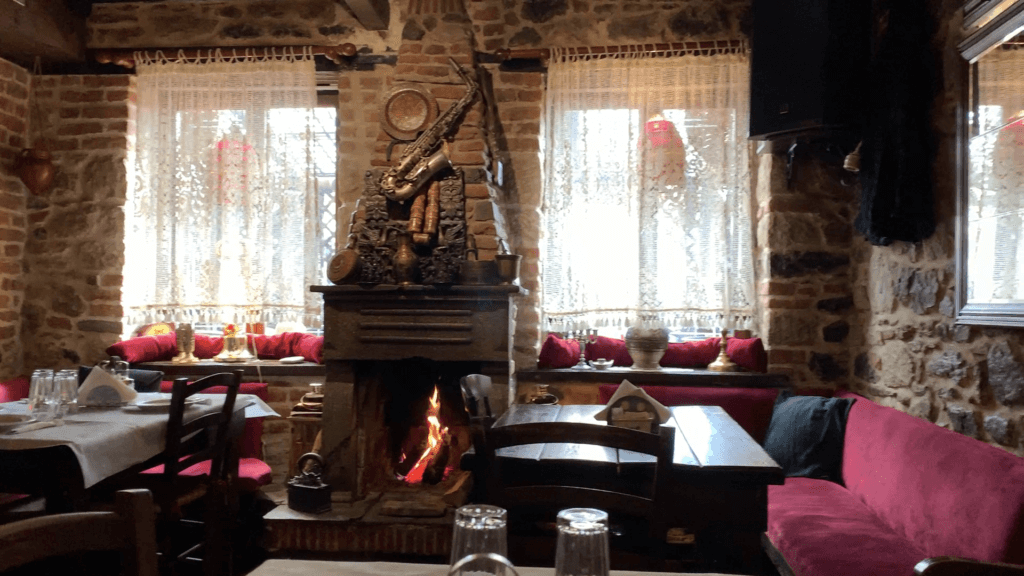
Lunch & Dinner
If you only eat at one restaurant in Korca, make it Vila Cofiel. The ambiance inside the restaurant is charming with traditional decorations and music. There was even a fire going in the wood-burning fireplace the night we went. I tried the rabbit, which the waiter recommended as one of their specialties, and Stevo had a pork chop which he enjoyed. We shared the house salad and red peppers stuffed with cheese and honey, which were unlike any other stuffed peppers we’ve had during our Albania travels. I still dream about them! Our waiter brought us glasses of traditional grape raki before our meal and glasses of baked apple raki at the end that smelled just like Christmas. We finished off the meal with a small bowl of sticky cherry preserves, which were also on the house. It was a delicious way to kick off our first night in Korca!
Taverna Vasili is a local Korca steakhouse serving up different cuts of meat, salads, soups, and sides. We tried the lemon soup with short noodles, which was the best soup I’ve had in all of Albania. And we’ve had a lot of soups here! We also got kernace, which are handmade meatballs, served with fresh red onions, which was a delicious combo. Stevo ordered a steak with cheese and was very happy (once he picked out all the mushrooms). I really don’t think you can go wrong at this restaurant!
Along Bulevardi Republika, a main road in Korca, there are many good restaurants including Find Four, which has a mix of traditional Albanian dishes and western options, Secret, which has more Italian options like pizza, calzone, and salads, and Theo Zoi which is a fast food restaurant serving gyros.
Another recommendation which we didn’t get to try is Villa Themistokli.
Day Trips Outside of Korca

Voskopojë, Albania
During our time in Korca, we took a day trip by bus to a nearby town called Voskopojë.
Voskopojë was founded in the early 14th century and was inhabited by Albanians, Aromanians, and Greeks. The small town was famous for having the second printing house in the Ottoman Empire after the first in Constantinople (modern-day Istanbul).
During the city’s peak in the 18th century, there were around 24-30 churches in Voskopojë. Today, only five of those churches remain intact along with the ruins of several others.
In the late 1700s, the city was attacked and destroyed during a succession of invasions, most notably by Ali Pasha’s troops. Many of Voskopojë’s inhabitants left the city at that time.
While we were there, we happened to meet the town’s only priest! He let us see inside the Church of St. Nicholas where we got to view untouched frescos that are over 300 years old!
From what we have heard, Voskopojë is a popular place to go in the winter as there are snow sports you can do there.
To reach Voskopojë you can catch a bus from the main bus terminal in Korçë (Google Map). The bus will drop you in the center of Voskopojë near the tourism office.
We caught an 11am bus from Korçë, but there may be earlier options. At the time we went in April 2022, the buses returning from Voskopojë to Korçë were at 1pm and 4pm. The bus price was 150 Lek per person each way.
WATCH: Exploring 300-Year-Old Churches in Voskopojë, Albania ~ Outside Korçë
Pogradec and Lake Ohrid
Lake Ohrid is one of Europe’s oldest and deepest lakes. It straddles the border between Albania and Northern Macedonia.
On the Albania side you can visit a city called Pogradec, which is the largest Albanian city along the lake. It is located about 40 Km north of Korca.
We didn’t have a chance to go to Pogradec or Lake Ohrid this trip. However, we did drive through Pogradec and around the lake on the bus ride from Tirana to Korca and it looked beautiful! From what we were told, you could easily do a day trip from Korca to Lake Ohrid, or you can choose to stay in Pogradec overnight.
The towns surrounding Lake Ohrid on the Northern Macedonia side are said to be especially beautiful. Read more about Lake Ohrid.
You can reach Pogradec by bus from the bus station in Korca. You will need to go there in person to inquire about bus times. You can also hire a taxi to bring you there.
Another option is to book a tour from Tirana to visit Pogradec, Lake Ohrid, and Korca.
There is a festival called “Lake Day” that takes place in Pogradec and other larger cities surrounding Lake Ohrid on 21 June. Local delicacies, including food and culture are showcased at the festival. Be sure to double check the date and details before you book your trip!
Do you want to get more of a feel for what Korca is like? Watch our Korca videos on YouTube:
First Days in Korçë, Albania
Breaking into the Korca Brewery (Accidentally!) in Korçë Albania
We hope you found this article helpful!
My wife and I will be arriving at Tirana airport at 11:50 on 26 July 2023. We need to travel to Korçë.
According to this website, buses depart for Korçë 6:00/7:30/8:30/9:30/10:30 (Startpoint at Qemal Stafa Stadium) 11:00/12:00/13:00/14:00/15:00/16:00 (Startpoint at Qytet Studenti). Please confirm these times and start points.
Hi Nicholas,
We aren’t sure if those times are still accurate as they seem to change throughout the year. You’ll probably need to go in person to book your bus ticket and be a bit flexible. Enjoy your time in Korçë!